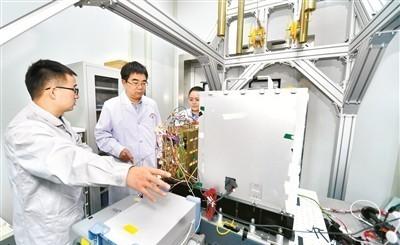
Zhang Shougang (center), director of the National Timing Center of the Chinese Academy of Sciences and chief scientist, communicated with members of the scientific research team in the Space Narrow LineWidth Laser Laboratory. Photo by Xinhua News Agency reporter Zhang Bowen
At the Space Strontium Atomic Light Clock Laboratory of the National Timing Center of the Chinese Academy of Sciences, the measuring instruments display relevant experimental signals. Photo by Xinhua News Agency reporter Zhang Bowen
Beijing time is China's national standard time, which does not actually come from Beijing, but originates in Shaanxi and is issued by the National Timing Center in Shaanxi.
Timing refers to the generation, retention, and transmission of time information in a certain way. Since the 1960s, several generations of Chinese researchers have taken root in the northwest, achieving breakthroughs in key technologies of "zero" again and again, and achieving independent and controllable timing technology. Today, Zhang Shougang, director of the National Timing Center of the Chinese Academy of Sciences and chief scientist, and his "time team" have reduced the deviation between continental standard time and international standard time from 100 nanoseconds to less than 5 nanoseconds, making its overall performance rank among the top in the world.
Patriotism is the source of strength for bravely climbing the peaks of science. In 1967, the 13th International Conference of Weights and Measures decided to change the definition of time units from astronomical time to atomic time, and the high-performance atomic clock, which has a fundamental role in the time system, has become a strategic resource for all countries to compete. In 1998, after a visit to China, a well-known Western physicist said that the experimental study of atomic clocks in China relied on "luck". This sentence made Zhang Shougang determined to make an atomic clock with long Chinese ambition. Starting from almost zero foundation, today, the Quantum Frequency Standard Research Office of the National Timing Center has nearly 100 young and middle-aged scientific researchers, independently developed the international advanced benchmark type cesium atom fountain clock, successfully broke the foreign monopoly, and firmly grasped the "time" in its own hands. "Wherever the national interest expands, our timing services follow." This is the common belief of Chinese timemakers.
Scientific research has always been a "chore". Atomic clocks are the crystallization of cutting-edge theories and cutting-edge technologies, and it is the norm to make an atomic clock in ten years or more. In the team, some people suffered from lumbar disc herniation for a long time and did not have time to go for surgery, and some people jumped into the laboratory during the Spring Festival holiday with a plaster cast and crutches. Chang Hong, a researcher engaged in the development of strontium atomic light clocks, experienced the death of his parents due to illness in the critical stage of scientific research. But he always told himself that in this strategic highland that the whole world is staring at, if he wants to seize it, the time window is only one or two years, and the national plan cannot be delayed here. Patriotism has never been an empty phrase, and the choice of "big" and "small" by scientific researchers records the mainland's unswerving ambition to take the road of independent innovation, and also supports our confidence and confidence in gnawing hard bones.
Scientific exploration is never-ending. In the past 31 years, Zhang Shougang has led the team to develop 9 new atomic clocks with different application types. He said: "Clock making is a cause worth paying for in a lifetime, because this is the strategic need of the country; making clocks is also a cause that cannot be completed in a lifetime, because the development and progress of all walks of life have endless requirements for the performance of atomic clocks, including the convenience of use." At present, the development of science and technology in the mainland still needs to continue to tackle key problems in core technologies, and strive to achieve autonomy and control in more key areas. No matter what changes in conditions, patriotic dedication, willingness to be lonely, and tireless cultivation will surely support us to continue to climb one scientific and technological peak after another.
Source: China Discipline Inspection and Supervision Daily